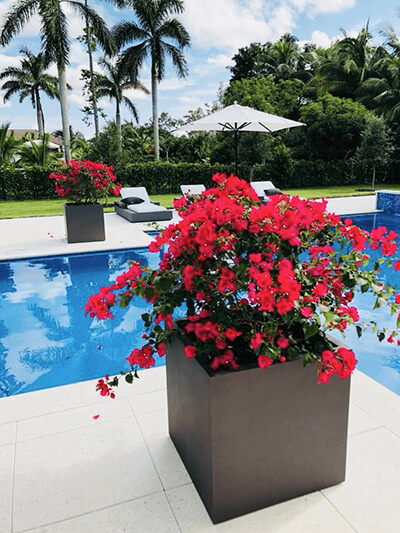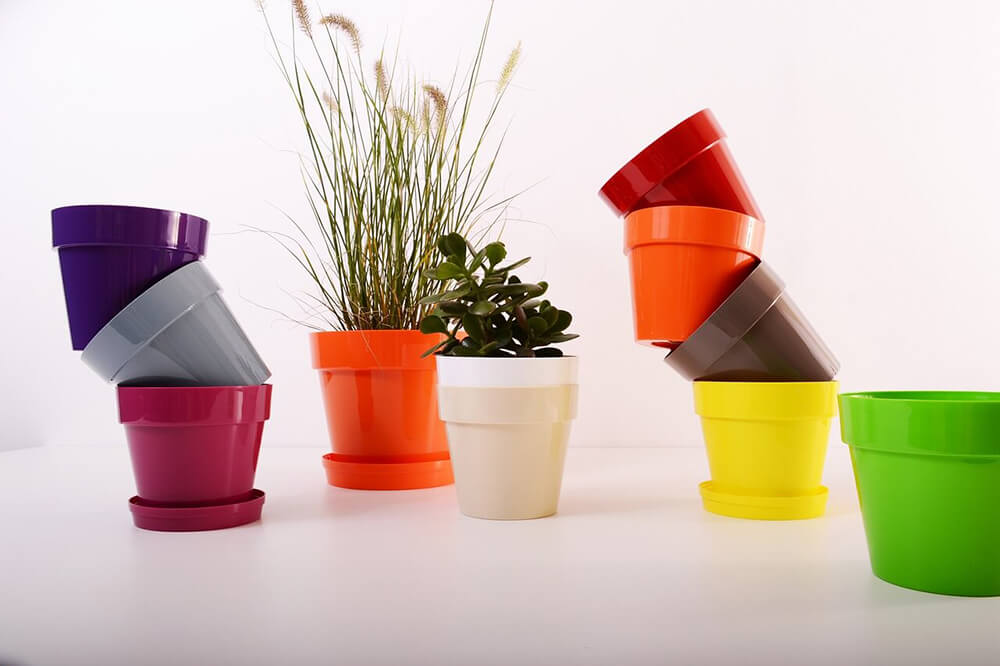The Best Types of Pots for Plants
Posted by Jason Wyrwicz on Apr 9th 2024
Planters are more than just a pretty container for your plants. They play a crucial role in a plant's health and growth, influencing everything from moisture retention to root development. Choosing the right planter involves considering various factors such as material, size, and shape. Let’s explore the wide variety of planters, equipping you with the knowledge to choose the ideal vessel for your indoor and outdoor botanical companions.
The 8 Best Planter Materials
Choosing the best material depends on several factors, including the plant's needs, your watering habits, and the overall aesthetic. Let's explore the key features of the most popular planter materials.
Planter Material Comparison Chart
| Feature | Fiberglass | Plastic | Wooden | Metal | Glass | Ceramic | Concrete | Terracotta |
|---|---|---|---|---|---|---|---|---|
| Durability | High | Moderate | Moderate | High | Fragile | High | Very high | Moderate |
| Lightweight | Yes | Yes | No | It varies | No | No | No | No |
| UV protection | No | It varies | No | No | No | No | No | No |
| Insulation | Yes | Yes | No | No | Yes | Yes | Yes | Yes |
| Moisture retention | Moderate | Low | Moderate | Low | High | High | Low | Low |
| Visually appealing | Yes | Yes | Yes | Yes | Yes | Yes | No | Yes |
| Cost | Moderate to high | Low | Moderate | Moderate to high | High | Moderate to high | High | Low |
| Indoor/outdoor use | Both | Both | Mostly Indoor | Both | Mostly indoor | Indoor | Outdoor | Outdoor |
| Harsh weather resistance | Yes | Yes | No | Yes | It varies | It varies | Yes | Yes |
| Quality | Yes | No | No | Yes | Yes | Yes | No | No |
1. Fiberglass planters

©Jay Scotts
Fiberglass planters offer a lightweight and durable alternative to traditional materials like ceramic or concrete. They can resemble other materials like ceramic or concrete in appearance, but at a fraction of the weight. They're suitable for both indoor and outdoor use and often come with built-in drainage holes. However, they can be more expensive than plastic planters.
Pros:
- Lightweight and durable, making them easier to move than heavier options
- Can resemble other materials like ceramic or concrete for a more upscale look
- Suitable for both indoor and outdoor use
- Often come with built-in drainage holes
Cons:
- Can be more expensive than plastic planters
- May not be as aesthetically pleasing to some as natural materials like terracotta or ceramic
2. Plastic planters

Lightweight and affordable, plastic planters come in a vast array of sizes and colors. They're often used for starter plants or as temporary housing. Drainage holes are common, but not always present - make sure to look for planters with drainage saucers to prevent waterlogging. Some higher-quality plastics offer UV protection to prevent cracking in direct sunlight.
Pros:
- Affordable and readily available
- Lightweight and easy to move around
- Diverse range of sizes and colors to suit any decor
- Many have drainage holes, suitable for most plants
- Some offer UV protection for extended outdoor use
Cons:
- Can crack or become brittle over time, especially in direct sunlight without UV protection
- Less aesthetically pleasing than some other options
- May not breathe well, leading to root rot if overwatered. Choose breathable plastic varieties whenever possible.
3. Wooden planters

Wooden planters offer a natural, rustic charm and come in various sizes and styles. They provide good insulation for roots, making them suitable for temperature-sensitive plants. Cedar and redwood are naturally rot-resistant choices, while other woods require a sealant to prevent moisture damage and warping. Consider using a drainage liner to protect the wood from excess moisture.
Pros:
- Beautiful, natural aesthetic complements many decors
- Good insulation for plant roots, beneficial for temperature-sensitive varieties
- Can be quite large to accommodate expansive root systems
Cons:
- Can rot or warp if not properly sealed with a weatherproof sealant
- Heavy, especially when wet, making them difficult to move
- May require more frequent watering as wood absorbs moisture
4. Metal planters

Metal planters add a touch of elegance or a rustic vibe depending on the type of metal. They're typically made from galvanized steel, copper, or aluminum. While stylish and long-lasting, metal conducts heat readily, so consider plant placement to avoid overheating roots. Drainage holes are often absent, requiring liners or very well-draining soil mixes. Copper planters can develop a beautiful patina over time, adding to their unique character.
Pros:
- Stylish and durable, especially with thicker metals like galvanized steel or copper
- Lightweight (aluminum) or rustic (galvanized steel) options available
- Can add a unique touch to your decor, especially copper which develops a patina
Cons:
- Prone to rust if not treated with a protective coating, especially steel
- Metal heats up quickly in sunlight, potentially stressing roots. Choose lighter colored metals or position plants in indirect sunlight.
- Drainage is often absent, requiring special attention to watering with liners or well-draining soil.
5. Glass planters

Glass planters offer a modern, elegant look and allow you to observe root growth visually. While perfect for moisture-loving plants like ferns and certain terrarium setups, they generally don't breathe well and can magnify sunlight, burning roots. They're also quite fragile and can chip or break easily. Opt for tempered glass for added durability.
Pros:
- Modern, sleek aesthetic for a contemporary look
- Allows for observation of root growth, helpful for monitoring plant health
- Suitable for some moisture-loving plants that thrive in humid environments
Cons:
- Fragile and can break easily, especially if bumped or dropped. Consider tempered glass for added safety.
- Heavy, especially in larger sizes, making them difficult to move
- Not ideal for most plants as glass traps moisture and intensifies sunlight, potentially leading to root burn. Opt for indirect sunlight for most plants in glass containers.
6. Ceramic planters

Ceramic planters offer a wide variety of styles and colors, making them a popular choice for indoor plants. They come in glazed and unglazed options. Glazed ceramic planters are non-porous and retain moisture well, while unglazed planters allow for better airflow and drainage. Consider the plant's needs when choosing between glazed and unglazed. Ceramic planters can be heavy, especially in larger sizes.
Pros:
- Wide variety of styles and colors to suit any decor
- Glazed options retain moisture well, suitable for plants that prefer consistent moisture levels
- Unglazed options allow for better airflow and drainage, ideal for plants that require good drainage
Cons:
- Can be heavy, especially in larger sizes, making them difficult to move
- Glazed pots can trap moisture if not paired with well-draining soil, potentially leading to root rot
- More expensive than some other options, especially for elaborately designed pieces
7. Concrete planters

Concrete planters are incredibly durable and heavy, making them perfect for windy areas or outdoor spaces where pots might tip over easily. The weight also provides stability for larger plants. Concrete comes in various shapes and textures, adding a bold statement piece to your patio or garden. They can be smooth and modern, or feature a rough, industrial aesthetic. However, their weight makes them difficult to move once planted, and their porous nature can lead to rapid drying of the soil. Consider placing them on coasters to prevent staining surfaces.
Pros:
- Very durable and won't tip over easily, ideal for outdoor use in windy locations
- Heavy for added stability for large plants
- Available in interesting shapes and textures, adding a modern or industrial feel to your decor
Cons:
- Extremely heavy, making them difficult to move or arrange, especially after planting
- Porous, so they can dry out soil quickly, requiring more frequent watering
- Expensive, especially for larger sizes
8. Terracotta planters

A classic and affordable option, terracotta planters are made from baked clay. The natural terracotta color complements many decors and offers a rustic charm. Their porous nature allows for good airflow and excellent drainage through the pot walls and base. This prevents root rot from overwatering. However, they dry out soil quickly, requiring more frequent watering, especially during hot weather. Terracotta is also brittle and can crack or break easily if dropped. Opt for glazed terracotta for a more colorful option, but be aware that glazing can reduce breathability.
Pros:
- Classic, affordable option readily available in most garden centers
- Natural terracotta color complements many decors
- Porous, allowing for good airflow and excellent drainage, preventing root rot
- Dries out quickly, reducing the risk of overwatering
Cons:
- Dries out soil quickly, requiring frequent watering, especially in hot or dry climates
- Brittle and can crack or break easily if dropped or bumped
- Glazed terracotta can be less breathable, potentially impacting watering needs
Best Planter Shapes
While material plays a crucial role in drainage, moisture retention, and root health, the shape of the planter can also significantly impact your plant's growth and overall look. Let's discover the strengths of the top planter shapes and learn how they can elevate your plant growing journey.
1. Round planters

©Jay Scotts
Round planters are the classic choice for a reason. Their symmetrical design offers a timeless elegance that complements any plant.
Round pots provide ample space especially for bushy plants to grow outwards, allowing their full form to take center stage.Think overflowing African violets or cascading ferns – round planters let them flourish without restrictions.
For single statement plants like a majestic Fiddle Leaf Fig or a sculptural Jade plant, round planters create a natural focal point. The circular shape draws the eye towards the plant, highlighting its unique form and character.
2. Square planters

©Jay Scotts
While round planters offer aesthetic appeal, square planters excel in maximizing space. Their straight edges allow them to be positioned neatly side-by-side, creating a clean and organized look.
Square planters work wonders in contemporary spaces. Their geometric form creates a sense of balance and order, especially when paired with clean lines and minimalistic furniture.
Grouping smaller flowering plants like pansies or violas in square planters creates a vibrant and colorful display. The clean lines of the squares complement the delicate blooms, adding a touch of modern charm.
3. Rectangular planters

©Jay Scotts
Rectangular planters offer a perfect blend of space efficiency and functionality. They combine the space-saving benefits of squares with added depth, making them ideal for specific plant needs.
Rectangular planters are perfect for creating rows of vegetables, flowers, or even small shrubs. This makes them ideal for raised garden beds or maximizing limited balcony space.
The elongated shape of rectangular planters can be used to visually define spaces on your patio or balcony. Line a pathway with vibrantly colored flowers in rectangular pots to create a welcoming entrance.
How to Choose the Best Planter Size?
The key to choosing the right pot size lies in understanding your plant's root system. Roots need space to grow, but not an excessive amount. Too little space can restrict growth and hinder the plant's health, while too much space can lead to overwatering issues.
As a general rule, most plants thrive in a pot that's 1-2 inches larger in diameter than their current pot. Here's how to measure:
- Pot diameter: This refers to the distance across the top of the pot. Don't confuse it with the volume (gallons) sometimes listed for larger planters.
- Current pot size: Measure the diameter of the pot your plant is currently in (excluding the rim).
Have a look a the standard planter size chart below to learn find out what planter size you will need for your plants:
| Pot Sizes (inches) | Pot Equivalent (U.S. Gallons) | Suitable Plants | Soil Needed (cu.ft.) and Weight (lbs) |
|---|---|---|---|
| 4" pot | 0.125 gallon | Nursery plants / Seedlings | 0.01 ft³ / 0.137 lbs |
| 5-6" pot | 0.25 gallon | Small succulents / 1 Annual | 0.03 ft³ / 0.27 lbs |
| 7-8" pot | 1 gallon | Larger succulents / 2 Annuals / Ornamental Grass | 0.13 ft³ / 1.1 lbs |
| 10" pot | 3 gallon | Small herbs such as Chives / Up to 3 annuals | 0.40 ft³ / 3.3 lbs |
| 12" pot | 5 gallon | Lettuce / Spinach / Strawberries | 0.66 ft³ / 5.5 lbs |
| 14" pot | 7 gallon | Larger herbs such as Rosemary | 0.94 ft³ / 7.7 lbs |
| 16" pot | 10 gallon | Small shrubs / Small fruits such as Raspberry | 1.33 ft³ / 11 lbs |
| 18" pot | 15 gallon | Vegetables such as tomato plants / Mix of annuals | 2.00 ft³ / 16.5 lbs |
| 24" pot | 25 gallon | Evergreen shrubs / Dwarf trees | 3.34 ft³ / 27.5 lbs |
| 30" pot | 30 gallon | Larger plants / Small trees | 4.01 ft³ / 30 lbs |
| 32" pot | 35 gallon | Large shrubs & trees: Palm trees, Boxwood | 4.68 ft³ / 35.5 lbs |
| 36" pot | 40 gallon | Larger trees: Orchard fruit trees such as Apple | 5.00 ft³ / 37 lbs |
| 44" pot | 45 gallon | Fully grown trees: Pine, Spruce, Hawthorn | 5.53 ft³ / 41 lbs |
*All figures are estimates and exact specifications largely depend on the manufacturer and shape of the planter
Are you planning to grow a fruit tree in a planter? You can use this handy pot size calculator to estimate the size of your pot so that it’s big enough for your tree.
Create Your Garden Oasis with Pots, Planters & More
Choosing the right pot for your plant is like composing a symphony – each element plays a crucial role in creating a harmonious and thriving masterpiece.
Now that you've learned the secrets to choosing the perfect planter, it's time to create your own botanical haven. Explore the exquisite collection of high-quality fiberglass planters at Pots, Planters & More. We offer a variety of shapes, sizes, and styles to match your unique plant needs and décor. Let us guide you towards the perfect pot that will help your plants flourish and bring your green symphony to life.
Want to know more? We're happy to answer any questions you have about our planters. Get in touch with us today!



